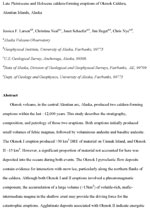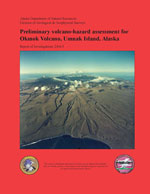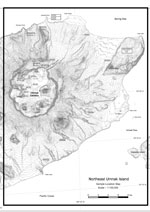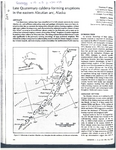Okmok CFE I
Start: 12000 yBP [1]
Event Type: Explosive
Max VEI: 4 [2]
- Phreato-magmatic [6]
- Pyroclastic flow, surge, or nuee ardente [5]
- Debris-avalanche, volcanic avalanche, or landslide [5]
Description: From Beget and others (2005): "The oldest deposits of Okmok Volcano that post-date the last ice age record a complex series of very large eruptions culminating in the development of a summit caldera (fig. 5 [in original text]). This late Pleistocene-early Holocene eruption generated voluminous deposits with compositions ranging from rhyodacite (70 wt. % SiO2) to basaltic-andesite (54 wt. % SiO2). It produced broadly synchronous welded pyroclastic flows, thick surge deposits, and debris avalanche deposits that together are as much as 100 meters thick on the northern flanks of Okmok Volcano. Pyroclastic flows and surges produced during these eruptions traveled to the coast and far out to sea around the volcano. The most distant deposit preserved on land was produced by a flow that crossed the waters of 7-kilometer-wide Umnak Pass to the westernmost part of Unalaska Island, traveling at least 21 kilometers from the vent. Surge deposits from this eruption also crossed Mt. Idak (fig. 2 [in original text]), climbing over a 200-meter scarp at a distance of 15 kilometers from the caldera rim. A debris avalanche also occurred at this time, but the debris avalanche deposits are very poorly preserved. The debris avalanche, found only on the north flank of the volcano, probably occurred during collapse of the former summit during the creation of the large caldera. Radiocarbon dates from directly beneath the pyroclastic flow deposits from this first caldera-forming eruption on westernmost Unalaska Island, and dates associated with distal volcanic ash deposits from these eruptions found near the city of Unalaska 100 kilometers to the east (Bean, 1999), both indicate the first caldera-forming eruption occurred about 12,000 years ago."
From Miller and Smith (1987): "The Okmok volcanic center, Umnak Island (Fig. 1 [in original text]), is a large basaltic composite volcano with a caldera system marking the summit area. This system consists of two large partially overlapping calderas (Byers, 1959), each with an estimated diameter of about 10 km. Postglacial ash-flow tuffs exposed in sea-cliff exposures on the northwest side of the volcano are locally separated by a lava flow 6-9 m thick (Miller and Smith, 1975). A hiatus between extrusion of the lava and deposition of the upper ash-flow sheet is indicated by a well-developed erosional surface on the lava flow; in places, stream channels were cut through the lava flow and later filled by the younger ash flow. The occurrence of two major ash-flow units strongly supports the probability of two major caldera-forming eruptions in Holocene time."
From Larsen and others (2007): "No soils exist beneath the Okmok I unit on Umnak Island. However, one radiocarbon date from a thin soil between the Okmok I deposits from on westernmost Unalaska Island (03JLOK64), and another from beneath distal tephras near the city of Unalaska about 100 km away, indicate the Okmok I eruption occurred about 12,000 14C yBP (Bean, 1999; Begét and others, 2005)."
"The Okmok I basal surge and fall layers comprise 4-6 km3, the main pyroclastic flow deposits are 14 to 21 km3, and the top surge layers are 2 to 3 km3. The total volume estimate for Okmok I on Umnak Island ranges from ~21 to ~31 km3, within the bounds described above. These estimates do not account for the estimated total volume of the depression thought to remain from the Okmok I eruption (~50 km3), or the volume of material that was deposited into the oceans."
The Global database on large magnitude explosive volcanic eruptions (LaMEVE; 2017) reports a magnitude of 6.7, bulk eruptive volume of 50 cubic km and a dense rock equivalent eruptive volume of 26 cubic km for the eruption.
From Miller and Smith (1987): "The Okmok volcanic center, Umnak Island (Fig. 1 [in original text]), is a large basaltic composite volcano with a caldera system marking the summit area. This system consists of two large partially overlapping calderas (Byers, 1959), each with an estimated diameter of about 10 km. Postglacial ash-flow tuffs exposed in sea-cliff exposures on the northwest side of the volcano are locally separated by a lava flow 6-9 m thick (Miller and Smith, 1975). A hiatus between extrusion of the lava and deposition of the upper ash-flow sheet is indicated by a well-developed erosional surface on the lava flow; in places, stream channels were cut through the lava flow and later filled by the younger ash flow. The occurrence of two major ash-flow units strongly supports the probability of two major caldera-forming eruptions in Holocene time."
From Larsen and others (2007): "No soils exist beneath the Okmok I unit on Umnak Island. However, one radiocarbon date from a thin soil between the Okmok I deposits from on westernmost Unalaska Island (03JLOK64), and another from beneath distal tephras near the city of Unalaska about 100 km away, indicate the Okmok I eruption occurred about 12,000 14C yBP (Bean, 1999; Begét and others, 2005)."
"The Okmok I basal surge and fall layers comprise 4-6 km3, the main pyroclastic flow deposits are 14 to 21 km3, and the top surge layers are 2 to 3 km3. The total volume estimate for Okmok I on Umnak Island ranges from ~21 to ~31 km3, within the bounds described above. These estimates do not account for the estimated total volume of the depression thought to remain from the Okmok I eruption (~50 km3), or the volume of material that was deposited into the oceans."
The Global database on large magnitude explosive volcanic eruptions (LaMEVE; 2017) reports a magnitude of 6.7, bulk eruptive volume of 50 cubic km and a dense rock equivalent eruptive volume of 26 cubic km for the eruption.
References Cited
[1] The Holocene eruptive history of Makushin Volcano, Alaska, 1999
Bean, K. W., 1999, The Holocene eruptive history of Makushin Volcano, Alaska: University of Alaska Fairbanks unpublished M.S. thesis, Fairbanks, AK, 130 p.[2] Volcanoes of the World, 2013
Global Volcanism Program, 2013, Volcanoes of the World, v. 4.5.3. Venzke, E (ed.): Smithsonian Institution. Downloaded 2017. http://dx.doi.org/10.5479/si.GVP.VOTW4-2013[3] Volcanoes of North America: United States and Canada, 1990
Wood, C. A., and Kienle, Juergen, (eds.), 1990, Volcanoes of North America: United States and Canada: New York, Cambridge University Press, 354 p.[4] Late Quaternary caldera-forming eruptions in the eastern Aleutian arc, Alaska, 1987
Miller, T. P., and Smith, R. L., 1987, Late Quaternary caldera-forming eruptions in the eastern Aleutian arc, Alaska: Geology, v. 15, n. 5, p. 434-438.[5] Preliminary volcano-hazard assessment for Okmok Volcano, Umnak Island, Alaska, 2005
Beget, J.E., Larsen, J.F., Neal, C.A., Nye, C.J., and Schaefer, J.R., 2005, Preliminary volcano-hazard assessment for Okmok Volcano, Umnak Island, Alaska: Alaska Division of Geological & Geophysical Surveys Report of Investigation 2004-3, 32 p., 1 sheet, scale 1:150,000.[6] Late Pleistocene and Holocene caldera-forming eruptions of Okmok Caldera, Aleutian Islands, Alaska, 2007
Larsen, J. F., Neal, Christina, Schaefer, Janet, Beget, Jim, and Nye, Chris, 2007, Late Pleistocene and Holocene caldera-forming eruptions of Okmok Caldera, Aleutian Islands, Alaska, in Eichelberger, John, Gordeev, Evgenii, Izbekov, Pavel, Kasahara, Minoru, and Lees, Jonathan, eds., Volcanism and Subduction: The Kamchatka Region: Geophysical Monograph 172, American Geophysical Union, p. 343-364.Complete Eruption References
Volcanoes of the World, 2013
Global Volcanism Program, 2013, Volcanoes of the World, v. 4.5.3. Venzke, E (ed.): Smithsonian Institution. Downloaded 2017. http://dx.doi.org/10.5479/si.GVP.VOTW4-2013
Global database on large magnitude explosive volcanic eruptions (LaMEVE), 2012
Crosweller H.S., Arora, B., Brown, S.K., Cottrell, E., Deligne, N.I., Guerrero, N.O., Hobbs, L., Kiyosugi, K., Loughlin, S.C., Lowndes, J., Nayembil, M., 2012, Global database on large magnitude explosive volcanic eruptions (LaMEVE): Journal of Applied Volcanology, v. 1, n. 4, unpaged.
Late Pleistocene and Holocene caldera-forming eruptions of Okmok Caldera, Aleutian Islands, Alaska, 2007
Larsen, J. F., Neal, Christina, Schaefer, Janet, Beget, Jim, and Nye, Chris, 2007, Late Pleistocene and Holocene caldera-forming eruptions of Okmok Caldera, Aleutian Islands, Alaska, in Eichelberger, John, Gordeev, Evgenii, Izbekov, Pavel, Kasahara, Minoru, and Lees, Jonathan, eds., Volcanism and Subduction: The Kamchatka Region: Geophysical Monograph 172, American Geophysical Union, p. 343-364.

Preliminary volcano-hazard assessment for Okmok Volcano, Umnak Island, Alaska, 2005
Beget, J.E., Larsen, J.F., Neal, C.A., Nye, C.J., and Schaefer, J.R., 2005, Preliminary volcano-hazard assessment for Okmok Volcano, Umnak Island, Alaska: Alaska Division of Geological & Geophysical Surveys Report of Investigation 2004-3, 32 p., 1 sheet, scale 1:150,000.

Magmatic differentiation at an island-arc caldera: a stratigraphically constrained multi-isotope study of Okmok Volcano, Aleutian Islands, Alaska, 2004
Finney, B.M., 2004, Magmatic differentiation at an island-arc caldera: a stratigraphically constrained multi-isotope study of Okmok Volcano, Aleutian Islands, Alaska: University of Bristol Ph.D. dissertation, 296 p.

Catalog of the historically active volcanoes of Alaska, 1998
Miller, T. P., McGimsey, R. G., Richter, D. H., Riehle, J. R., Nye, C. J., Yount, M. E., and Dumoulin, J. A., 1998, Catalog of the historically active volcanoes of Alaska: U.S. Geological Survey Open-File Report 98-0582, 104 p.

Volcanoes of North America: United States and Canada, 1990
Wood, C. A., and Kienle, Juergen, (eds.), 1990, Volcanoes of North America: United States and Canada: New York, Cambridge University Press, 354 p.
Hard Copy held by AVO at FBKS - CEC shelf
Late Quaternary caldera-forming eruptions in the eastern Aleutian arc, Alaska, 1987
Miller, T. P., and Smith, R. L., 1987, Late Quaternary caldera-forming eruptions in the eastern Aleutian arc, Alaska: Geology, v. 15, n. 5, p. 434-438.
